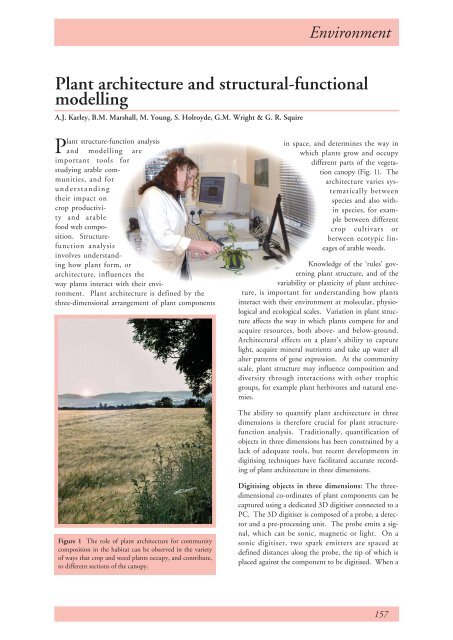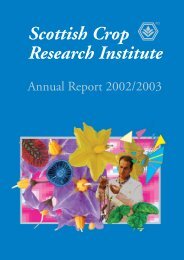SCRI Annual Report 2003/2004 - Scottish Crop Research Institute
SCRI Annual Report 2003/2004 - Scottish Crop Research Institute
SCRI Annual Report 2003/2004 - Scottish Crop Research Institute
Create successful ePaper yourself
Turn your PDF publications into a flip-book with our unique Google optimized e-Paper software.
Environment<br />
Plant architecture and structural-functional<br />
modelling<br />
A.J. Karley, B.M. Marshall, M. Young, S. Holroyde, G.M. Wright & G. R. Squire<br />
Plant structure-function analysis<br />
and modelling are<br />
important tools for<br />
studying arable communities,<br />
and for<br />
understanding<br />
their impact on<br />
crop productivity<br />
and arable<br />
food web composition.<br />
Structurefunction<br />
analysis<br />
involves understanding<br />
how plant form, or<br />
architecture, influences the<br />
way plants interact with their environment.<br />
Plant architecture is defined by the<br />
three-dimensional arrangement of plant components<br />
in space, and determines the way in<br />
which plants grow and occupy<br />
different parts of the vegetation<br />
canopy (Fig. 1). The<br />
architecture varies systematically<br />
between<br />
species and also within<br />
species, for example<br />
between different<br />
crop cultivars or<br />
between ecotypic lineages<br />
of arable weeds.<br />
Knowledge of the ‘rules’ governing<br />
plant structure, and of the<br />
variability or plasticity of plant architecture,<br />
is important for understanding how plants<br />
interact with their environment at molecular, physiological<br />
and ecological scales. Variation in plant structure<br />
affects the way in which plants compete for and<br />
acquire resources, both above- and below-ground.<br />
Architectural effects on a plant’s ability to capture<br />
light, acquire mineral nutrients and take up water all<br />
alter patterns of gene expression. At the community<br />
scale, plant structure may influence composition and<br />
diversity through interactions with other trophic<br />
groups, for example plant herbivores and natural enemies.<br />
The ability to quantify plant architecture in three<br />
dimensions is therefore crucial for plant structurefunction<br />
analysis. Traditionally, quantification of<br />
objects in three dimensions has been constrained by a<br />
lack of adequate tools, but recent developments in<br />
digitising techniques have facilitated accurate recording<br />
of plant architecture in three dimensions.<br />
Figure 1 The role of plant architecture for community<br />
composition in the habitat can be observed in the variety<br />
of ways that crop and weed plants occupy, and contribute,<br />
to different sections of the canopy.<br />
Digitising objects in three dimensions: The threedimensional<br />
co-ordinates of plant components can be<br />
captured using a dedicated 3D digitiser connected to a<br />
PC. The 3D digitiser is composed of a probe, a detector<br />
and a pre-processing unit. The probe emits a signal,<br />
which can be sonic, magnetic or light. On a<br />
sonic digitiser, two spark emitters are spaced at<br />
defined distances along the probe, the tip of which is<br />
placed against the component to be digitised. When a<br />
157
















